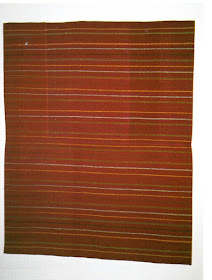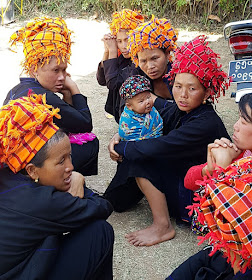Hello all,
Today I will continue talking about the various peoples of Myanmar, or Burma.
Karenic Speaking Peoples
This map shows southern Myanmar and western Thailand. The various Karen languages are shown on this map in dark green, Kayah in light yellowish green. Mon in crimson.
Karen or Kayin
The Karen languages form a unique and very distinct branch of the Sino-Tibetan language family. These people are made up of many groups which speak related languages, and are called, by outsiders, Karen, Kayin, Kariang, or Yang. They live in Karen or Kayin State, shown in yellow on the map above, inland Tanintharyi Region, across the border in Thailand, in enclaves in the Irrawady River Delta, and also scattered in parts of Shan State. The two major groups of the Karen people are the Sgaw and the Pwo, but there are others. The image at the head of the article is of Karen. Both Sgaw and Pwo are found throughout the Karen speaking area. The basic garment of the Karen is two woven pieces of cloth sewn together to each other, and also at the sides, forming a sort of tunic. Openings are left unsewn for the head and arms. Young people wear only a long garment of this type, married women wear a shorter tunic and a wrap skirt. Men used to wear only a somewhat shorter tunic and a loincloth, but nowadays often wear a longyi or pants on the lower body. These cloth panels are often intricately woven, and may also have embroidery and/or seedwork.
Karen young people dancing. Great music and performance, but they are in modern clothing, t shirts and longyi.
Sgaw
This first image shows a bride on the left,and a bridesmaid on the right.

The following are closer views of Sgaw tunics, showing woven ormament, embroidery and seedwork.
The following are some Sgaw wrapskirts. Many feature an ikat 'python skin' design in the center.
Sgaw New Years Song. It is definitely been degraded by pop music influence.
https://www.youtube.com/watch?v=C8NwlX7Fb0Y
Pwo
Some examples of Pwo tunics, again showing woven ornament, embroidery and seedwork.
Paku
The Paku speak a language related to Sgaw. The costume is somewhat distinct. They live in northern Kayin State and southern Kayah State.
Karen dance. Group not mentioned, but the girls are wearing Paku Karen type tops. The costume is modernized and adapted for stage.
The Bwe or Kayaw, are found in Karenni State, and to some extant over the border in Thailand. https://en.wikipedia.org/wiki/Bwe_people
Bwe Karen traditional music
Bwe Karen swimming and catching fish to make fish sauce.
Kayah
The Kayah are also known as the Karenni, which is Burmese for 'Red Karen'. They live in Kayah State, north of Kayin State which is shown in violet on the map above, and over the border into Shan State and Thailand as well. The Bwe are sometimes considered to be a subgroup of the Kayah. The women traditionally wore a cloth wrapped around the torso and a multitude of lacquered cotton rings around the legs.
A group performing Kayah dances to some awful pop songs
A performance of Kayah dance in Singapore, again to modern music, and in modern costume adaptation.
Kayan
The Kayan are a subgroup of the Karenni. The Burmese call them Padaung. They are famous for the traditional habit of their women wearing multiple brass rings around their necks. Because of this they have been much photographed both in Burma and in Thailand, where they live.
Kayan young people dancing. The music isnt too bad.
https://www.youtube.com/watch?v=L2Y6XqgRZwM
A better view of modern style costumes.
https://www.youtube.com/watch?v=GTZ4H2lodMI
Pa O
The Pa'O, or Thaungthu, speak languages that form yet another branch of the Karennic language family. They are quite numerous, and many live in western Shan State, shown in Green on the map above, in the Pa O Self Administered Zone, shown in green on the map below.
The Pa O wear black or indigo outfits with colored turbans. They claim that they once wore colorful clothing, but at some point in the past were forced to wear black by a despotic local ruler.
Unfortunately, like many other southeast Asian peoples, they often replace the traditional turban with commercially produced towels.
Pa O girls dancing on stage.
A Pa O music video. I could not find one with decent resolution
One more showing boys and girls dancing
Hill Tribes
These are various peoples who live in the eastern part of Shan State, and who arrived on the territory of Burma relatively recently [ie. within the last 200 yrs or so], in contrast to the peoples which I have covered so far. Most have their major centers of population to the east of Myanmar, and are often scattered through China, Thailand, Laos, and sometimes Vietnam.
Miao -Yao
This is a relatively small language family, which has not been convincingly linked to any other. It includes the languages of the Hmong and relatives, the Mien and relatives, as well as the She and the Pa Then. I have talked about all of these in other articles. I have not found statistics as to numbers, but there seem to be few of these people in Myanmar.
Hmong
The Hmong are the westernmost representatives of the Miao People. They are renowned everywhere they live for their embroidery, batik, and costumes. There are two groups found in Burma.They are part of the same population that are found in Laos and Thailand I have written about the Hmong here. https://folkcostume.blogspot.com/2017/11/introduction-to-costumes-of.html
Blue or Green Hmong
White Hmong.
The white skirt for which this group is named is often no longer worn.
Hmong Procession in Myanmar
https://www.youtube.com/watch?v=f3U9CIFBOFI
Hmong New Year celebration in Myanmar
https://www.youtube.com/watch?v=_TQBNMDEoJk
Mien
https://en.wikipedia.org/wiki/Yao_people
The Mien are the westernmost members of the Yao People. Again, they form part of the same group which is found in Laos and Thailand. The Mien also have much embroidery on their costumes, especially on the womens' pants. I have written about the Mien here. https://folkcostume.blogspot.com/2017/12/introduction-to-costumes-of_15.html
Loloish Group
https://en.wikipedia.org/wiki/Loloish_languages
This group of peoples is originally native to Yunnan, but have spread south and west into other countries. There are many such small peoples, but two are counted among the hill tribes of eastern Shan State.
Lahu
https://en.wikipedia.org/wiki/Lahu_people
The Lahu are found in Yunnan, Laos, Vietnam and Thailand as well as eastern Shan State.They are known for silver ornaments as well as patchwork and applique on their clothing. There are two distinct groups of Lahu in Burma, each of which have subgroups. I have written about them here. https://folkcostume.blogspot.com/2019/09/overview-of-costumes-of-lesser-known_22.html
Black Lahu or Lahu Na
Lahu Sheh Leh - another branch of the Black Lahu
Red Lahu or Lahu Nyi
A video of a Lahu song. They keep returning to shots of 5 young couples dancing in Shan, Bamar, Lahu, Lisu and Akha costumes. The people in the meeting house are in Lahu outfits. I dont get why the golf and pickups are there.
https://www.youtube.com/watch?v=Th1gdra-52U
A visit to a Lahu Shi village in Myanmar, showing in part some traditional music and dance. Also showing off traditional costume of this subgroup.
https://www.youtube.com/watch?v=NhB8zEX0C_E
Akha
https://en.wikipedia.org/wiki/Akha_people
The Akha are another Loloish speaking group that originated in Yunnan. They are found in Shan State, Yunnan, Northern Laos and Thailand. They have a particular devotion to their traditions, called 'The Akha Way'. Their costumes are rich in ornament, especially the traditional womens' headdresses. They are made up of several groups. I have written more about Akha costumes here.https://folkcostume.blogspot.com/2019/10/overview-of-costumes-of-lesser-known.html
Akha girls dancing on stage
https://www.youtube.com/watch?v=TUeK-JHkZFU
Akha music video. The shots keep jumping between three different schlocky stage costumes and really beautiful traditional Akha costume of a different group than the first video.
https://www.youtube.com/watch?v=OK2MIqhHQsE
It looks like I will have to have a part three to this article.
Thank you for reading, I hope that you have found this to be interesting and informative.
Roman K
Source Material:
David and Barbara Fraser, 'Mantles of Merit - Chin textiles from Myanmar, India and Bangladesh', Bangkok, 2005
Aglaja Stirn and Peter Van Ham, 'The Hidden world of the Naga', New York, 2003
Michael C Howard, 'Textiles of the Hill Tribes of Burma', Bangkok, 1999
Margaret Campbell, 'From the Hands of the Hills', Hong Kong, 1978
Paul and Elaine Lewis, 'Peoples of the Golden Triangle' London, 1984
Gittinger & Lefferts, 'Textiles and the Tai Experience in Southeast Asia', Washington, D.C., 1992,
Patricia Cheesman Naenna, 'Costume and Culture; Vanishing Textiles of some of the Tai groups in Laos', Chiang Mai, Thailand, 1990\
Prangwatthanakum and Naenna, 'Lan Na Textiles - Yuan Lue Lao', Bangkok, 1990
Dell and Dudley, 'Textiles from Burma', 2003, London
Maya McLean, 'Dress and Tai Yai Identity in Thoed Thai, Northern Thailand', 2012, Bangkok
Alexandra Green, 'Eclectic Collecting - Art from Burma in the Denison Museum', 2008, Honolulu
'Dress and Festivities of the Minority Peoples of Yunnan', 2004, China
Yos Santosombat, 'Lak Chang - a reconstruction of Tai identity in Daikong', 2001. Canberra
Frank LeBar, et al, 'Ethnic Groups of Mainland Southeast Asia', New Haven Ct., 1964
Susan Conway, 'Thai Textiles', London, 1992
Richard K. Diran, 'The Vanishing Tribes of Burma', London, 1997
Unknown Author. 'Dress and Festivals of the Minority Peoples of Yunnan', Yunnan, 2004
Dr
Florian Knothe et al, 'Embroidered Identities Ornately Decorated
Textiles and Accessories of Chinese Ethnic Minorities' 2014, Hong Kong
Jim Goodman, 'The Exploration of Yunnan', Kunming, 2006
Deng Qiyao et al, 'The Folk Arts of Yunnan Ethnics', Yunnan, 1993
Chen Hongguang et al, 'Ethnic Costumes Clothing Decorations from China', Chengdu, Sichuan, 1995
Bernard Formoso, 'Costumes du Yunnan', Nanterre, 2013
Shan Ren et al, 'The Cream of Yunling - A Photo Odyssey of Yunnan Ethnic Groups', Kunming, 1998


































































































































Hi,
ReplyDeleteCongratulations on your wonderful posts and researches, i always enjoy reading and learning for them.
I had created a facebook page dedicated to ethnic textiles from all over the wornd and iam sure our 6000+ strong community would be delighted to read your posts if you let them know when they are available.
join us on facebook @ethnic textiles community
We also run a sister page dedicated to jewelry and adornments @ethnic jewels community
Keep up the good work!